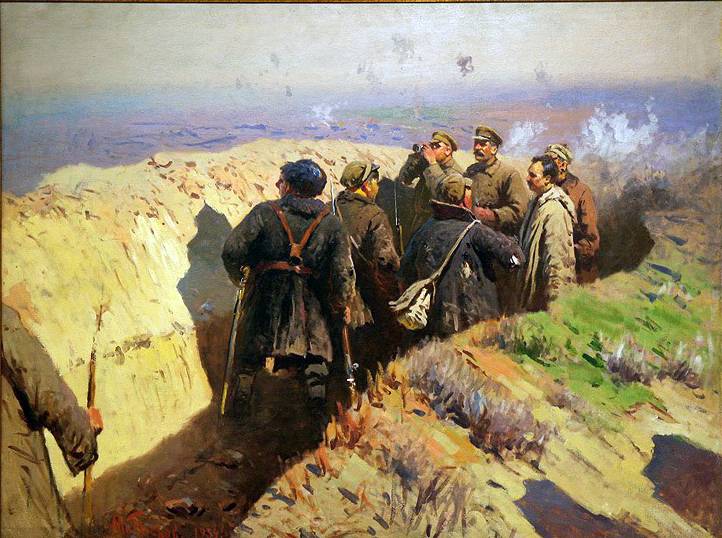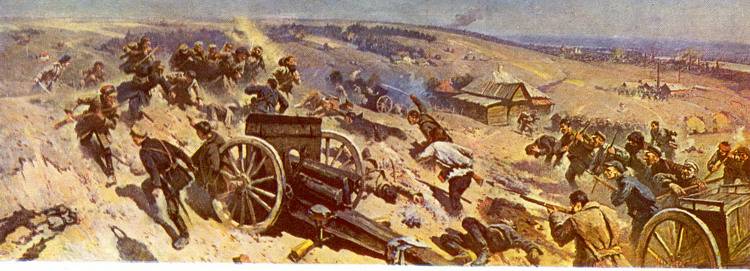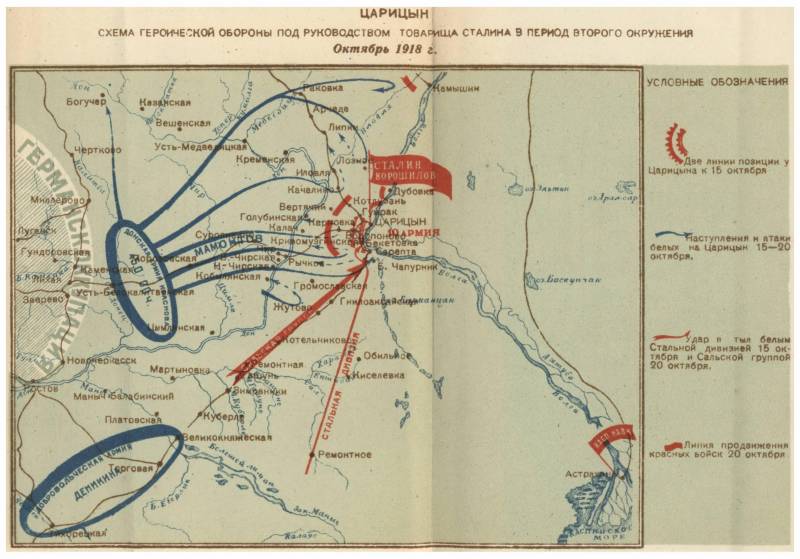The second battle for Tsaritsyn
prehistory
Don Ataman Krasnov did not want to come to terms with the failure of the August offensive of the Don Army against Tsaritsyn. The failure of the August offensive against Tsaritsyn and the successes of the Volunteer Army of General Denikin in the North Caucasus during the Second Kuban campaign strongly irritated and oppressed the ataman Krasnov, who clearly understood that without success on the front, the white Don government would not last long. Held in September 1918, the Don Circle decided on a new offensive against Tsaritsyn, according to which additional mobilization of the Cossacks into the army was launched.
In mid-September 1918, the Don Army launched a second attack on Tsaritsyn. Thousands of bayonets and sabers, 38 machine guns, 138 guns, 129 armored trains were thrown at the assault on the city. The 8 Defense Army of Tsaritsyn, the Red Army numbered 10 thousand bayonets and sabers, 40 machine guns, 200 guns, 152 armored trains. As a result, the forces of the parties were approximately equal.
The defense of Tsaritsyn was still led by JV Stalin and K. Ye. Voroshilov. From 12 to 20 September, there was no Stalin in Tsaritsyn on 1918, he temporarily left for Moscow to address a number of issues. On September 15, a meeting of V.I. Lenin, J.M.Sverdlov and I.V. Stalin on the Tsaritsyn Front was held. September 17 JV Stalin appointed a member of the Revolutionary Military Council of the Southern Front. KE Voroshilov was appointed a member of the RVS of the Southern Front and Assistant Commander of the Southern Front P. P. Sytin. September 22 Stalin returns from Moscow to Tsaritsyn. Voroshilov during this period is doing an enormous amount of work to put in order the Red troops exhausted by almost six-week continuous battles (First Defense). Tired, exsanguinated units replaced the reserve ones, replenished the troops, and for this purpose carried out new mobilization of workers and peasants, restored stocks of ammunition, repaired armored trains, armored vehicles, etc.
The second defense of Tsaritsyn
21 September 1918, the Cossack army launched an offensive and defeated the 10 th Red Army, dropping it from the beginning of October from the Don to the Tsaritsyn suburbs. Fierce battles unfolded 27 - September 30 in the central area - in the area Krivo-Muzginskaya. In late September, the White Guards began to act around the city from the south, October 2 captured Gniloksayskaya, October 8 - Tingutu. The Cossacks north and south of the city came to the Volga, cut the railway Tsaritsyn-Tikhoretskaya, taking the city in ticks.
In the first half of October, the Don army knocked out the Reds from the suburbs of Tsaritsyn: Sarepta, Beketovka, Otrada, leaving by October 15, 1918 to the last line of defense of the city. On October 15, 1918, in the Beketovka area, the Red Army soldiers of the 1st and 2nd peasant regiments switched to the side whites. A huge gap has formed in the defense of the Reds. The situation for the Reds was saved by two armored trains under the command of Alyabyev, who quickly moved to the breakthrough area and set fire to the enemy, who was tearing to the district railway. Later, another 100 artillery pieces were deployed there under the beginning of Kulik, the Volga ships flotilla.
October 17 whites prepared a decisive assault on Tsaritsyn. The situation was critical. The turning point at Tsaritsyn in favor of the 10 Red Army decided the arrival of the “Steel Division” Dmitry Zloby from the Caucasus, who quarreled with the commander-in-chief of the Red Army of the North Caucasus, Sorokin, and withdrew his division from the Caucasian front to Tsaritsyn. "Steel Division" "Steel" division made 800-km march from Nevinnomysskaya station to Tsaritsyn and October 15 delivered a crushing blow to assault units of the Don army from the rear. The strike between Tundutovo and Sarepta fell on the Astrakhan division of the Don Army. During the 45-minute battle "Steel Division" utterly defeated the enemy, and the commander of the Astrakhan detachment, General Demyanov, died and his headquarters was captured. After the defeat of the Astrakhan Division, the Don troops of the Northeast Front, commanded by General Mamantov, were threatened with encirclement and were forced to retreat from Tsaritsyn.
However, not only the Division of Goons turned the tide. The Red Command prepared a counterstrike. On October 17, all the artillery available at the front of the Don Army in the Voroponovo area was concentrated on all the front artillery - more than 200 guns and 10 armored trains (from 15 operating near Tsaritsyn). When the Cossacks launched an offensive, they were met with powerful artillery and machine-gun fire. Simultaneously, the Red Army men struck their ranks. After suffering heavy losses from the fire of red batteries and armored trains, White retreated. Even a lot of veteran soldiers were struck by this fierce battle. The ascent up the hill to Sadovaya and Voroponovo was literally littered with corpses. October 18 JV Stalin telegraphs VI Lenin about the defeat of Krasnov's troops near Tsaritsyn.
As a result, the second offensive of whites was reflected. The storming of the city failed, and the Reds launched a counterattack. Having suffered heavy losses, the Don Army began a retreat and by October 25 retreated beyond the Don. Many Cossack regiments were destroyed, and the Cossacks also lost a lot weapons, ammunition and ammunition, the reserves of which were now difficult to replenish (Germany could no longer replenish the stocks of the Don Republic).
In the winter of 1918 - 1819 of the year, White made a third attempt to take Tsaritsyn. December 21 Ust-Medveditskaya cavalry colonel Golubintsev launched an offensive, going to the Volga north of Tsaritsyn and cutting the red front. The Red Command threw the cavalry of Dumenko against Golubintsev. Fierce battles ensued, with varying success. Meanwhile, parts of General Mamantov came close to Tsaritsyn. To the south of Tsaritsyn, the red cavalry of Gorodovikov was defeated and thrown back to the outskirts of the city. However, frost and moral decay of parts of the Don Army, the Don attack on Tsaritsyn was stopped. In the middle of February, 1919 of the Don Army were forced to retreat from Tsaritsyn again.

M. Grekov. Comrades Stalin, Voroshilov and Shchadenko in the trenches near Tsaritsyn
Results
Thus, the Red Tsaritsyn resisted the onslaught of the Don army. The city on the Volga in 1918 could become perhaps the main symbol of the staunchness of the Red Army. The defenders of Tsaritsyn rejected the proposals of Ataman Krasnov for the surrender of the city. According to military expert L. L. Klyuyev, “Krasnov threatened both God and the Entente, and tanks, and gases. But these threats did not intimidate the defenders of the revolutionary Tsaritsyn. Red Tsaritsyn still stood like a granite rock. " Krasnov could not solve the problem of providing the Don region from the east. In turn, JV Stalin declared the defense of the city the central task of the day for Soviet Russia.
Tsaritsyn really had the most important military-political and strategic significance for Soviet Russia. If Tsaritsyn were taken in 1918, the Don troops could develop an offensive in the northern direction, the prospect of interaction and even the unification of the Don and Volga anti-Bolshevik fronts would arise. Keeping Tsaritsyn in this period allowed Red to use the fragmentation of white forces and beat the enemy piecemeal.
How not to relate to Stalin, but it is necessary to recognize that his presence in Tsaritsyn contributed to the fact that an effective defense system was organized in the city. In Tsaritsyn, Stalin consolidated his reputation as one of the most authoritative and tough organizers of the Bolshevik Party. Not surprisingly, it was precisely in Tsaritsyn that the confrontation of Stalin (Russian communists, Bolshevik-Stalinists) and Trotsky (revolutionists-internationalists, Trotskyists, acting in the interests of the West) began.
Also in Tsaritsyn, one could see KE Voroshilov and GI Kulik in the first roles and future marshals of the Soviet Union. Voroshilov, in fact, was very popular with the fighters and commanded the 10 army, often personally leading the battle. “There is nowhere to retreat, the Volga is behind us, there is one way ahead of us, towards the enemy,” Voroshilov told the Red Army men, and the soldiers, forgetting about fatigue, went ahead, crushing the enemy’s selective units. The name of Voroshilov in connection with the heroic defense of Tsaritsyn became known throughout the country. During the few months of the civil war, Clement Efremovich moved forward as one of the greatest red warlords, as a commander, beloved by ordinary soldiers, enjoying great prestige among junior commanders. Kulik was the commander of the artillery of the front, skillfully led her. Here, under Tsaritsyn, SM Budyonny also showed himself.
The organization for the first time in the Red Army of large equestrian formations is connected with the defense of Tsaritsyn. On 1 in November 1918 on the Tsaritsyn front there were already more than 10 thousand cavalrymen, of which Budenny's equestrian corps was later formed, which then deployed to the 1 Cavalry Army.
As a result, the defense of Tsaritsyn buried the plan to create a Cossack autonomous Don region. Cossacks, after defeats, began to decompose. The regular Cossack "Young Army" that was formed by Krasnov, despite the great attention paid to her by the ataman, did not become a serious force - her spirit was weak. The ataman even complained that the year was again repeated at the front. The Cossacks began to cross over to the side of the Bolsheviks and surrender to the Red Army, whose victories, according to Lenin, "did wonders." The Bolsheviks, with "tremendous rapidity," took possession of vast territories south of Tsaritsyn. As a result, by the end of December 1917, the Don was again threatened with the danger of the arrival of the Bolsheviks; only the White Volunteer Army could save the region from the Reds. Germany fell and could not already support its figure - Krasnov, it was necessary to replace the defeated Germanophiles with people who were guided by the Entente.
Aware of the inevitability of the Reds' powerful new offensive against the Don and submitting to the pressure of the Allies, Krasnov went towards the unification and submission to Denikin. Krasnov left his post, the Don Circle took it: the Reds were at this point in 16 versts from Novocherkassk, and the situation seemed hopeless even to the ataman’s closest entourage. 2 (15) February 1919. Krasnov’s resignation was accepted. The era of Krasnov is over, the ataman resigned from his post. The military ataman of the Don 6 Troops in February 1919 was chosen by General A. Bogaevsky, a brave officer, but modest and not claiming power. Now Don obeyed Denikin.

The defense of Tsaritsyn (fragment of the panorama). M. Grekov

Information